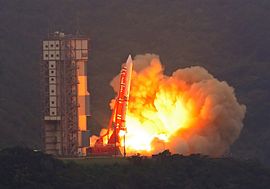M-V

The fifth M-V launches with the ASTRO-EII spacecraft.
|
|
| Function | All-solid small orbital launch vehicle |
|---|---|
| Manufacturer |
Nissan Motors (-2000) (-2006) |
| Country of origin | Japan |
| Size | |
| Height | 30.8 m (101 ft) |
| Diameter | 2.5 m (8.2 ft) |
| Mass | 137,500 - 139,000 kg (303,100 - 306,000 lb) |
| Stages | 3 or 4 |
| Capacity | |
| Payload to LEO | 1,800 kg (3,900 lb) |
| Payload to Polar LEO |
1,300 kg (2,800 lb) |
| Launch history | |
| Status | Retired |
| Launch sites | Kagoshima |
| Total launches | 7 (M-V: 4, M-V KM: 3) |
| Successes | 6 (M-V: 3, M-V KM: 3) |
| Failures | 1 (M-V) |
| First flight |
M-V: 10 February 2000 M-V KM: 12 February 1997 |
| Last flight |
M-V: 22 September 2006 M-V KM: 9 May 2003 |
| Notable payloads |
HALCA, Nozomi, ASTRO-E, Hayabusa Suzaku, AKARI Hinode |
| First stage - M-14 | |
| Engines | 1 Solid |
| Thrust | 3,780.345 kN (849,855 lbf) |
| Specific impulse | 246 sec |
| Burn time | 46 seconds |
| Fuel | Solid |
| Second stage - M-24 | |
| Engines | 1 Solid |
| Thrust | 1,245.287 kN (279,952 lbf) |
| Specific impulse | 203 sec |
| Burn time | 71 seconds |
| Fuel | Solid |
| Third stage - M-34 | |
| Engines | 1 Solid |
| Thrust | 294 kN (66,093 lbf) |
| Specific impulse | 301 sec |
| Burn time | 102 seconds |
| Fuel | Solid |
| Fourth stage (M-V KM) - KM-V1 | |
| Engines | 1 Solid |
| Thrust | 51.9 kN (11,668 lbf) |
| Specific impulse | 298 sec |
| Burn time | 73 seconds |
| Fuel | Solid |
The M-V rocket, also called M-5 or Mu-5, was a Japanese solid-fuel rocket designed to launch scientific satellites. It was a member of the Mu family of rockets. The Institute of Space and Astronautical Science (ISAS) began developing the M-V in 1990 at a cost of 15 billion yen. It has three stages and is 30.7 meters high, 2.5 meters in diameter, and weighs about 140 tonnes (310,000 pounds). It was capable of launching a satellite weighing 1.8 tonnes (2 short tons) into an orbit as high as 250 km (160 mi).
The first M-V rocket launched the HALCA radio astronomy satellite in 1997, and the second the Nozomi Mars explorer in July 1998. The third rocket attempted to launch the Astro-E X-ray satellite on February 10, 2000 but failed.
ISAS recovered from this setback and launched Hayabusa to 25143 Itokawa in 2003.
The following M-V launch was the scientific Astro-E2 satellite, a replacement for Astro-E, which took place on July 10, 2005.
The final launch was that of the Hinode (SOLAR-B) spacecraft, along with the SSSat microsat and a nanosatellite, HIT-SAT, on 22 September 2006.
A follow on to the M-V, called the Epsilon Rocket, featured a lower 1.2 tonne LEO payload capability. The development aim is to reduce costs, primarily by using the H-IIA solid rocket booster as the first stage and through shorter launch preparation time. Epsilon launches are intended to cost much less than the $70 million launch cost of a M-V.
...
Wikipedia
